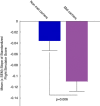BDNF polymorphism predicts the rate of decline in skilled task performance and hippocampal volume in healthy individuals
- PMID: 22833197
- PMCID: PMC3309489
- DOI: 10.1038/tp.2011.47
BDNF polymorphism predicts the rate of decline in skilled task performance and hippocampal volume in healthy individuals
Abstract
Numerous studies have indicated a link between the presence of polymorphism in brain-derived neurotrophic factor (BDNF) and cognitive and affective disorders. However, only a few have studied these effects longitudinally along with structural changes in the brain. This study was carried out to investigate whether valine-to-methionine substitution at position 66 (val66met) of pro-BDNF could be linked to alterations in the rate of decline in skilled task performance and structural changes in hippocampal volume. Participants consisted of 144 healthy Caucasian pilots (aged 40-69 years) who completed a minimum of 3 consecutive annual visits. Standardized flight simulator score (SFSS) was measured as a reliable and quantifiable indicator for skilled task performance. In addition, a subset of these individuals was assessed for hippocampal volume alterations using magnetic resonance imaging. We found that val66met substitution in BDNF correlated longitudinally with the rate of decline in SFSS. Structurally, age-dependent hippocampal volume changes were also significantly altered by this substitution. Our study suggests that val66met polymorphism in BDNF can be linked to the rate of decline in skilled task performance. Furthermore, this polymorphism could be used as a predictor of the effects of age on the structure of the hippocampus in healthy individuals. Such results have implications for understanding possible disabilities in older adults performing skilled tasks who are at a higher risk for cognitive and affective disorders.Translational Psychiatry (2011) 1, e51; doi:10.1038/tp.2011.47; published online 25 October 2011.
Figures




Similar articles
-
Brain-derived neurotrophic factor val66met polymorphism affects human memory-related hippocampal activity and predicts memory performance.J Neurosci. 2003 Jul 30;23(17):6690-4. doi: 10.1523/JNEUROSCI.23-17-06690.2003. J Neurosci. 2003. PMID: 12890761 Free PMC article. Clinical Trial.
-
Effects of brain-derived neurotrophic factor Val66Met polymorphism on hippocampal volume change in schizophrenia.Hippocampus. 2010 Sep;20(9):1010-7. doi: 10.1002/hipo.20699. Hippocampus. 2010. PMID: 19714565
-
Brain-derived neurotrophic factor polymorphism Val66Met influences cognitive abilities in the elderly.Genes Brain Behav. 2008 Jun;7(4):411-7. doi: 10.1111/j.1601-183X.2007.00363.x. Epub 2007 Oct 31. Genes Brain Behav. 2008. PMID: 17973920
-
The association of the BDNF Val66Met polymorphism and the hippocampal volumes in healthy humans: a joint meta-analysis of published and new data.Neurosci Biobehav Rev. 2014 May;42:267-78. doi: 10.1016/j.neubiorev.2014.03.011. Epub 2014 Mar 24. Neurosci Biobehav Rev. 2014. PMID: 24674929 Review.
-
The impact of BDNF Val66Met polymorphism on cognition in Bipolar Disorder: A review: Special Section on "Translational and Neuroscience Studies in Affective Disorders" Section Editor, Maria Nobile MD, PhD. This Section of JAD focuses on the relevance of translational and neuroscience studies in providing a better understanding of the neural basis of affective disorders. The main aim is to briefly summaries relevant research findings in clinical neuroscience with particular regards to specific innovative topics in mood and anxiety disorders.J Affect Disord. 2019 Jan 15;243:552-558. doi: 10.1016/j.jad.2018.07.054. Epub 2018 Jul 24. J Affect Disord. 2019. PMID: 30078664 Review.
Cited by
-
Investigating Predictors of Cognitive Decline Using Machine Learning.J Gerontol B Psychol Sci Soc Sci. 2020 Mar 9;75(4):733-742. doi: 10.1093/geronb/gby054. J Gerontol B Psychol Sci Soc Sci. 2020. PMID: 29718387 Free PMC article.
-
Brain-derived neurotrophic factor (BDNF) Val66Met polymorphism interacts with gender to influence cortisol responses to mental stress.Psychoneuroendocrinology. 2017 May;79:13-19. doi: 10.1016/j.psyneuen.2017.02.005. Epub 2017 Feb 13. Psychoneuroendocrinology. 2017. PMID: 28249185 Free PMC article.
-
Genetics and functional imaging: effects of APOE, BDNF, COMT, and KIBRA in aging.Neuropsychol Rev. 2015 Mar;25(1):47-62. doi: 10.1007/s11065-015-9279-8. Epub 2015 Feb 10. Neuropsychol Rev. 2015. PMID: 25666727 Review.
-
Genetics of stroke recovery: BDNF val66met polymorphism in stroke recovery and its interaction with aging.Neurobiol Dis. 2019 Jun;126:36-46. doi: 10.1016/j.nbd.2018.08.009. Epub 2018 Aug 15. Neurobiol Dis. 2019. PMID: 30118755 Free PMC article. Review.
-
Neurotrophins in the Brain: Interaction With Alcohol Exposure During Development.Vitam Horm. 2017;104:197-242. doi: 10.1016/bs.vh.2016.10.008. Epub 2016 Nov 29. Vitam Horm. 2017. PMID: 28215296 Free PMC article. Review.
References
-
- Chao MV. Trophic factors: an evolutionary cul-de-sac or door into higher neuronal function. J Neurosci Res. 2000;59:353–355. - PubMed
-
- Gotz R, Raulf F, Schartl M. Brain-derived neurotrophic factor is more highly conserved in structure and function than nerve growth factor during vertebrate evolution. J Neurochem. 1992;59:432–442. - PubMed
-
- Zhang X, Poo MM. Localized synaptic potentiation by BDNF requires local protein synthesis in the developing axon. Neuron. 2002;36:675–688. - PubMed
-
- Nakata H, Nakamura S. Brain-derived neurotrophic factor regulates AMPA receptor trafficking to post-synaptic densities via IP3R and TRPC calcium signaling. FEBS Lett. 2007;581:2047–2054. - PubMed
Publication types
MeSH terms
Substances
Grants and funding
LinkOut - more resources
Full Text Sources
Other Literature Sources

